Brand Management Report: Strategies for Optimum Impression Limited
VerifiedAdded on 2020/10/22
|18
|5647
|286
Report
AI Summary
This report delves into the critical aspects of brand management, providing a comprehensive overview of key concepts and strategies. It begins by defining brand management and its significance in enhancing the economic value of a brand. The report introduces Optimum Impression Limited and Nestle as case studies to illustrate various branding strategies. It explores the building blocks of a successful brand, including defining the target audience, brand mission, competitive analysis, value propositions, brand guidelines, and marketing. The report further examines the importance of brand equity, outlining strategies for strengthening it, such as effective communication, brand awareness, and the use of brand extension and revitalization techniques. The Keller brand equity model (CBBE) is discussed in detail, explaining the four levels of brand building: brand identity, brand meaning, brand response, and brand resonance. Additionally, the report analyzes brand portfolio and hierarchy management, including brand-of-house and house-of-brands strategies. The report provides an in-depth analysis of how brands are leveraged or extended and evaluates techniques for measuring and managing brands. Overall, the report offers valuable insights into the multifaceted world of brand management, providing practical strategies and real-world examples to enhance brand performance.
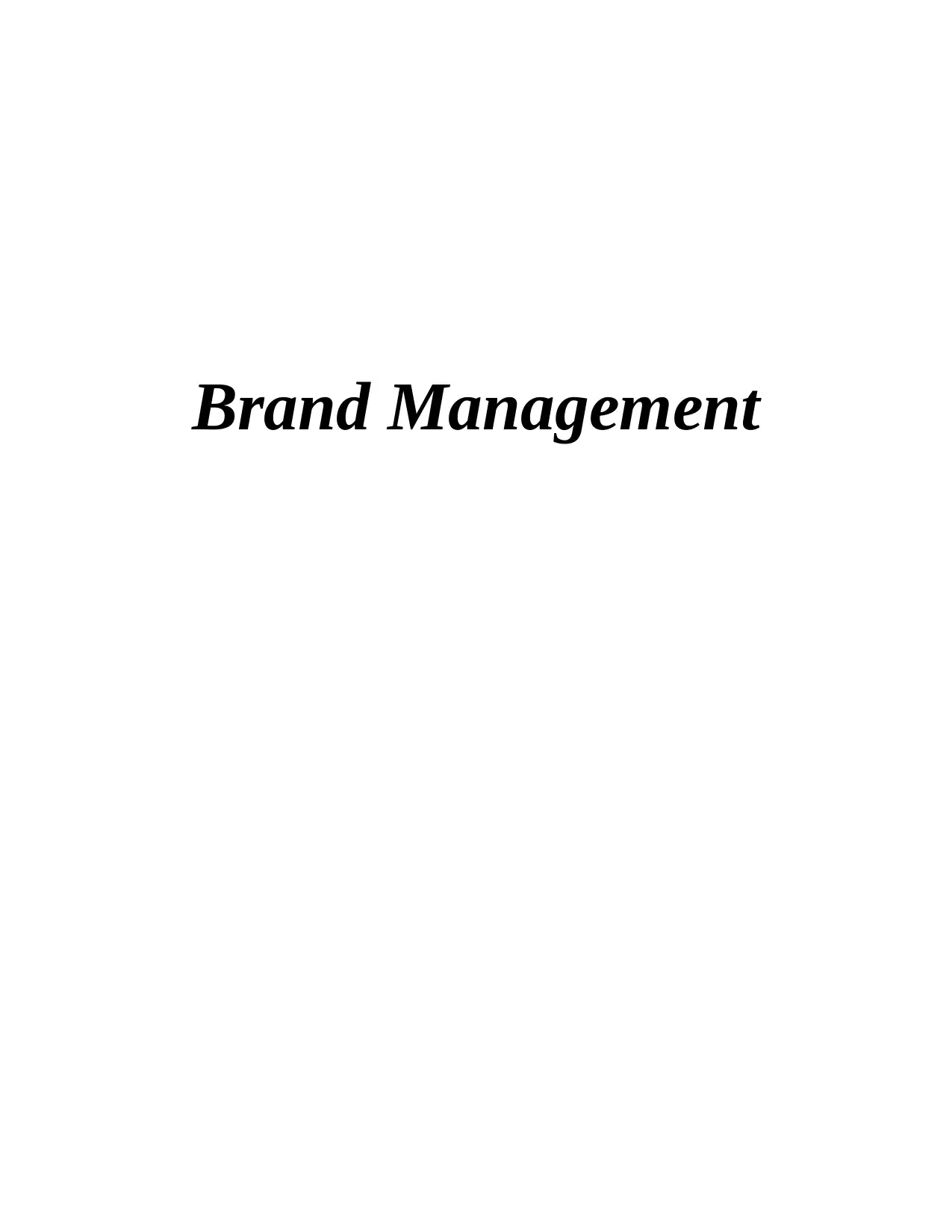
Brand Management
Paraphrase This Document
Need a fresh take? Get an instant paraphrase of this document with our AI Paraphraser
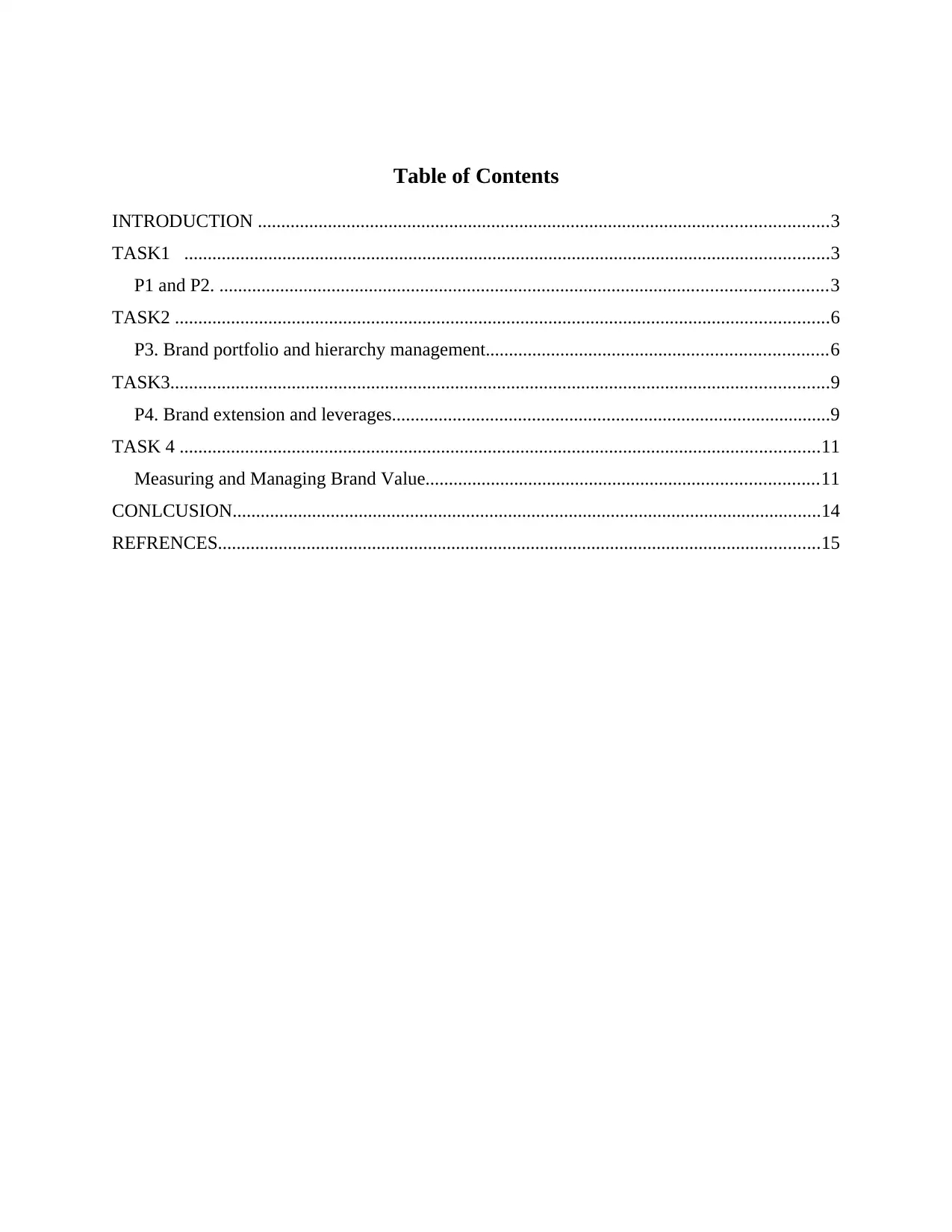
Table of Contents
INTRODUCTION ..........................................................................................................................3
TASK1 ..........................................................................................................................................3
P1 and P2. ..................................................................................................................................3
TASK2 ............................................................................................................................................6
P3. Brand portfolio and hierarchy management.........................................................................6
TASK3.............................................................................................................................................9
P4. Brand extension and leverages..............................................................................................9
TASK 4 .........................................................................................................................................11
Measuring and Managing Brand Value....................................................................................11
CONLCUSION..............................................................................................................................14
REFRENCES.................................................................................................................................15
INTRODUCTION ..........................................................................................................................3
TASK1 ..........................................................................................................................................3
P1 and P2. ..................................................................................................................................3
TASK2 ............................................................................................................................................6
P3. Brand portfolio and hierarchy management.........................................................................6
TASK3.............................................................................................................................................9
P4. Brand extension and leverages..............................................................................................9
TASK 4 .........................................................................................................................................11
Measuring and Managing Brand Value....................................................................................11
CONLCUSION..............................................................................................................................14
REFRENCES.................................................................................................................................15
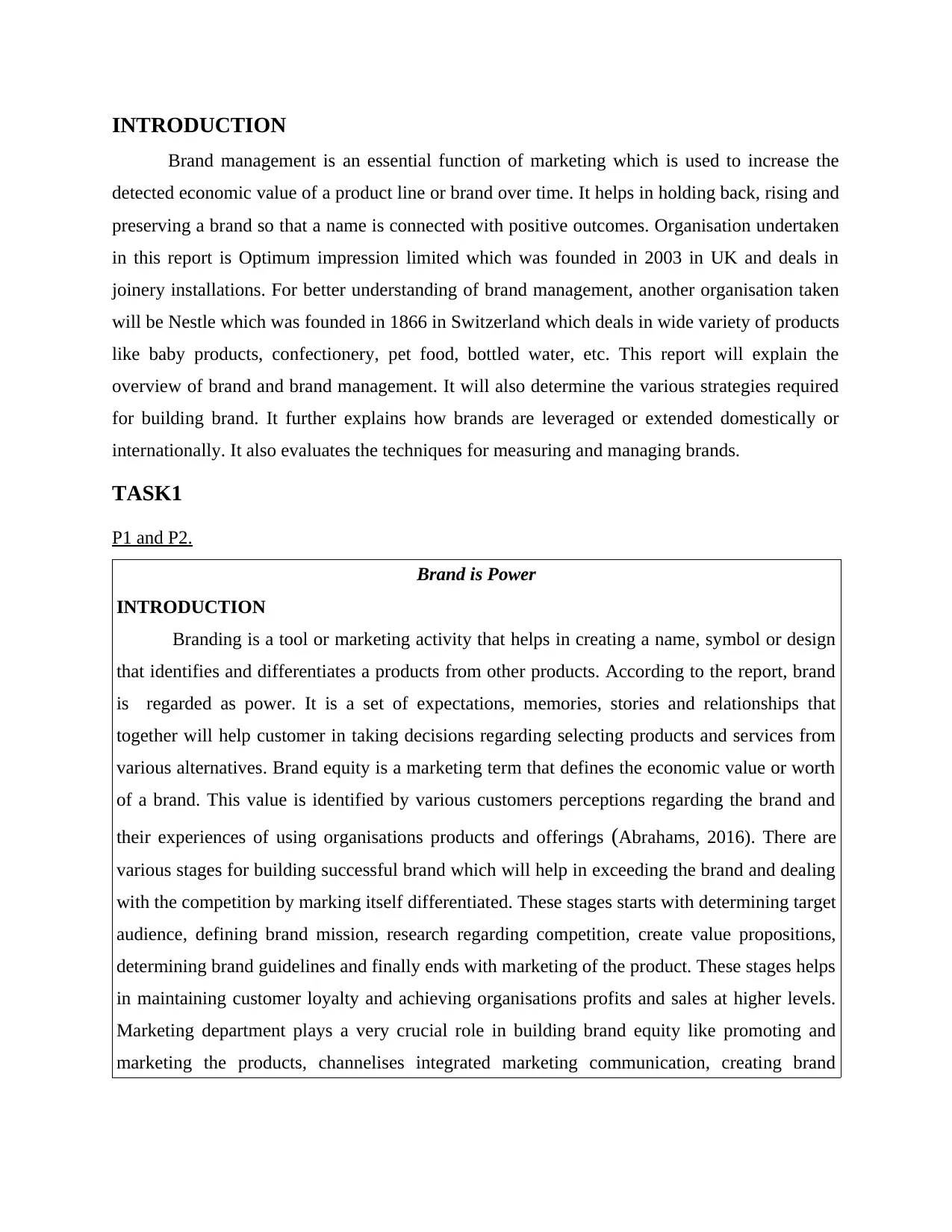
INTRODUCTION
Brand management is an essential function of marketing which is used to increase the
detected economic value of a product line or brand over time. It helps in holding back, rising and
preserving a brand so that a name is connected with positive outcomes. Organisation undertaken
in this report is Optimum impression limited which was founded in 2003 in UK and deals in
joinery installations. For better understanding of brand management, another organisation taken
will be Nestle which was founded in 1866 in Switzerland which deals in wide variety of products
like baby products, confectionery, pet food, bottled water, etc. This report will explain the
overview of brand and brand management. It will also determine the various strategies required
for building brand. It further explains how brands are leveraged or extended domestically or
internationally. It also evaluates the techniques for measuring and managing brands.
TASK1
P1 and P2.
Brand is Power
INTRODUCTION
Branding is a tool or marketing activity that helps in creating a name, symbol or design
that identifies and differentiates a products from other products. According to the report, brand
is regarded as power. It is a set of expectations, memories, stories and relationships that
together will help customer in taking decisions regarding selecting products and services from
various alternatives. Brand equity is a marketing term that defines the economic value or worth
of a brand. This value is identified by various customers perceptions regarding the brand and
their experiences of using organisations products and offerings (Abrahams, 2016). There are
various stages for building successful brand which will help in exceeding the brand and dealing
with the competition by marking itself differentiated. These stages starts with determining target
audience, defining brand mission, research regarding competition, create value propositions,
determining brand guidelines and finally ends with marketing of the product. These stages helps
in maintaining customer loyalty and achieving organisations profits and sales at higher levels.
Marketing department plays a very crucial role in building brand equity like promoting and
marketing the products, channelises integrated marketing communication, creating brand
Brand management is an essential function of marketing which is used to increase the
detected economic value of a product line or brand over time. It helps in holding back, rising and
preserving a brand so that a name is connected with positive outcomes. Organisation undertaken
in this report is Optimum impression limited which was founded in 2003 in UK and deals in
joinery installations. For better understanding of brand management, another organisation taken
will be Nestle which was founded in 1866 in Switzerland which deals in wide variety of products
like baby products, confectionery, pet food, bottled water, etc. This report will explain the
overview of brand and brand management. It will also determine the various strategies required
for building brand. It further explains how brands are leveraged or extended domestically or
internationally. It also evaluates the techniques for measuring and managing brands.
TASK1
P1 and P2.
Brand is Power
INTRODUCTION
Branding is a tool or marketing activity that helps in creating a name, symbol or design
that identifies and differentiates a products from other products. According to the report, brand
is regarded as power. It is a set of expectations, memories, stories and relationships that
together will help customer in taking decisions regarding selecting products and services from
various alternatives. Brand equity is a marketing term that defines the economic value or worth
of a brand. This value is identified by various customers perceptions regarding the brand and
their experiences of using organisations products and offerings (Abrahams, 2016). There are
various stages for building successful brand which will help in exceeding the brand and dealing
with the competition by marking itself differentiated. These stages starts with determining target
audience, defining brand mission, research regarding competition, create value propositions,
determining brand guidelines and finally ends with marketing of the product. These stages helps
in maintaining customer loyalty and achieving organisations profits and sales at higher levels.
Marketing department plays a very crucial role in building brand equity like promoting and
marketing the products, channelises integrated marketing communication, creating brand
⊘ This is a preview!⊘
Do you want full access?
Subscribe today to unlock all pages.

Trusted by 1+ million students worldwide
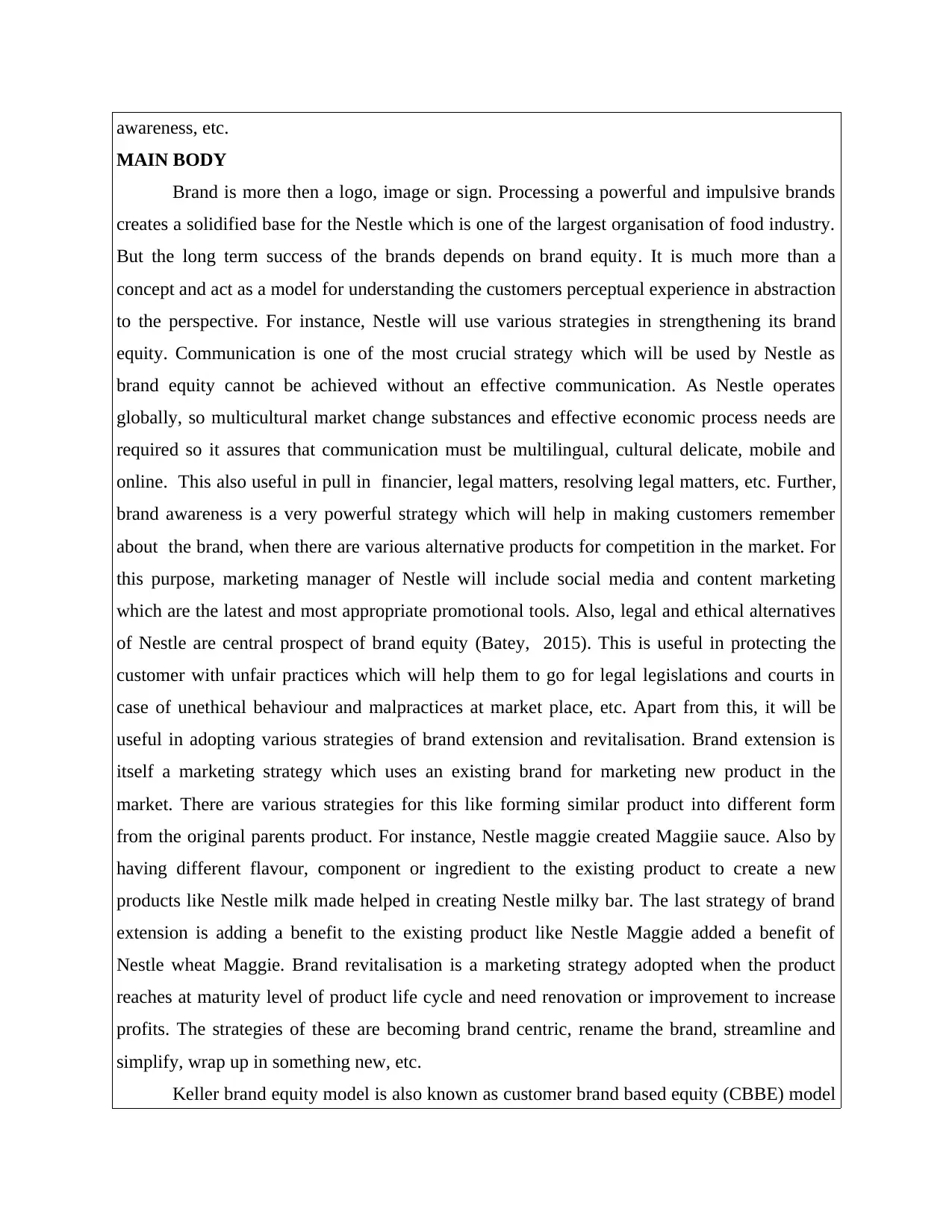
awareness, etc.
MAIN BODY
Brand is more then a logo, image or sign. Processing a powerful and impulsive brands
creates a solidified base for the Nestle which is one of the largest organisation of food industry.
But the long term success of the brands depends on brand equity. It is much more than a
concept and act as a model for understanding the customers perceptual experience in abstraction
to the perspective. For instance, Nestle will use various strategies in strengthening its brand
equity. Communication is one of the most crucial strategy which will be used by Nestle as
brand equity cannot be achieved without an effective communication. As Nestle operates
globally, so multicultural market change substances and effective economic process needs are
required so it assures that communication must be multilingual, cultural delicate, mobile and
online. This also useful in pull in financier, legal matters, resolving legal matters, etc. Further,
brand awareness is a very powerful strategy which will help in making customers remember
about the brand, when there are various alternative products for competition in the market. For
this purpose, marketing manager of Nestle will include social media and content marketing
which are the latest and most appropriate promotional tools. Also, legal and ethical alternatives
of Nestle are central prospect of brand equity (Batey, 2015). This is useful in protecting the
customer with unfair practices which will help them to go for legal legislations and courts in
case of unethical behaviour and malpractices at market place, etc. Apart from this, it will be
useful in adopting various strategies of brand extension and revitalisation. Brand extension is
itself a marketing strategy which uses an existing brand for marketing new product in the
market. There are various strategies for this like forming similar product into different form
from the original parents product. For instance, Nestle maggie created Maggiie sauce. Also by
having different flavour, component or ingredient to the existing product to create a new
products like Nestle milk made helped in creating Nestle milky bar. The last strategy of brand
extension is adding a benefit to the existing product like Nestle Maggie added a benefit of
Nestle wheat Maggie. Brand revitalisation is a marketing strategy adopted when the product
reaches at maturity level of product life cycle and need renovation or improvement to increase
profits. The strategies of these are becoming brand centric, rename the brand, streamline and
simplify, wrap up in something new, etc.
Keller brand equity model is also known as customer brand based equity (CBBE) model
MAIN BODY
Brand is more then a logo, image or sign. Processing a powerful and impulsive brands
creates a solidified base for the Nestle which is one of the largest organisation of food industry.
But the long term success of the brands depends on brand equity. It is much more than a
concept and act as a model for understanding the customers perceptual experience in abstraction
to the perspective. For instance, Nestle will use various strategies in strengthening its brand
equity. Communication is one of the most crucial strategy which will be used by Nestle as
brand equity cannot be achieved without an effective communication. As Nestle operates
globally, so multicultural market change substances and effective economic process needs are
required so it assures that communication must be multilingual, cultural delicate, mobile and
online. This also useful in pull in financier, legal matters, resolving legal matters, etc. Further,
brand awareness is a very powerful strategy which will help in making customers remember
about the brand, when there are various alternative products for competition in the market. For
this purpose, marketing manager of Nestle will include social media and content marketing
which are the latest and most appropriate promotional tools. Also, legal and ethical alternatives
of Nestle are central prospect of brand equity (Batey, 2015). This is useful in protecting the
customer with unfair practices which will help them to go for legal legislations and courts in
case of unethical behaviour and malpractices at market place, etc. Apart from this, it will be
useful in adopting various strategies of brand extension and revitalisation. Brand extension is
itself a marketing strategy which uses an existing brand for marketing new product in the
market. There are various strategies for this like forming similar product into different form
from the original parents product. For instance, Nestle maggie created Maggiie sauce. Also by
having different flavour, component or ingredient to the existing product to create a new
products like Nestle milk made helped in creating Nestle milky bar. The last strategy of brand
extension is adding a benefit to the existing product like Nestle Maggie added a benefit of
Nestle wheat Maggie. Brand revitalisation is a marketing strategy adopted when the product
reaches at maturity level of product life cycle and need renovation or improvement to increase
profits. The strategies of these are becoming brand centric, rename the brand, streamline and
simplify, wrap up in something new, etc.
Keller brand equity model is also known as customer brand based equity (CBBE) model
Paraphrase This Document
Need a fresh take? Get an instant paraphrase of this document with our AI Paraphraser
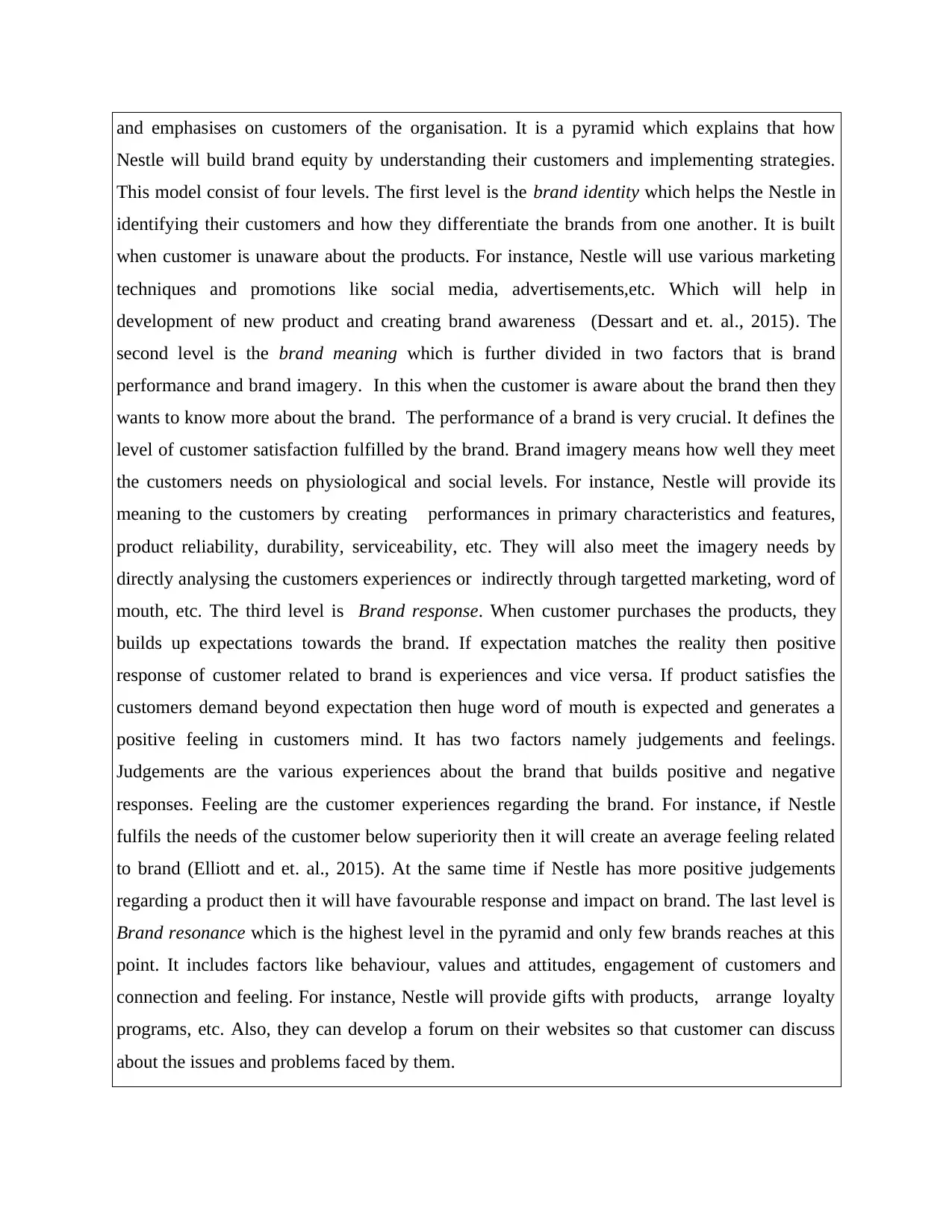
and emphasises on customers of the organisation. It is a pyramid which explains that how
Nestle will build brand equity by understanding their customers and implementing strategies.
This model consist of four levels. The first level is the brand identity which helps the Nestle in
identifying their customers and how they differentiate the brands from one another. It is built
when customer is unaware about the products. For instance, Nestle will use various marketing
techniques and promotions like social media, advertisements,etc. Which will help in
development of new product and creating brand awareness (Dessart and et. al., 2015). The
second level is the brand meaning which is further divided in two factors that is brand
performance and brand imagery. In this when the customer is aware about the brand then they
wants to know more about the brand. The performance of a brand is very crucial. It defines the
level of customer satisfaction fulfilled by the brand. Brand imagery means how well they meet
the customers needs on physiological and social levels. For instance, Nestle will provide its
meaning to the customers by creating performances in primary characteristics and features,
product reliability, durability, serviceability, etc. They will also meet the imagery needs by
directly analysing the customers experiences or indirectly through targetted marketing, word of
mouth, etc. The third level is Brand response. When customer purchases the products, they
builds up expectations towards the brand. If expectation matches the reality then positive
response of customer related to brand is experiences and vice versa. If product satisfies the
customers demand beyond expectation then huge word of mouth is expected and generates a
positive feeling in customers mind. It has two factors namely judgements and feelings.
Judgements are the various experiences about the brand that builds positive and negative
responses. Feeling are the customer experiences regarding the brand. For instance, if Nestle
fulfils the needs of the customer below superiority then it will create an average feeling related
to brand (Elliott and et. al., 2015). At the same time if Nestle has more positive judgements
regarding a product then it will have favourable response and impact on brand. The last level is
Brand resonance which is the highest level in the pyramid and only few brands reaches at this
point. It includes factors like behaviour, values and attitudes, engagement of customers and
connection and feeling. For instance, Nestle will provide gifts with products, arrange loyalty
programs, etc. Also, they can develop a forum on their websites so that customer can discuss
about the issues and problems faced by them.
Nestle will build brand equity by understanding their customers and implementing strategies.
This model consist of four levels. The first level is the brand identity which helps the Nestle in
identifying their customers and how they differentiate the brands from one another. It is built
when customer is unaware about the products. For instance, Nestle will use various marketing
techniques and promotions like social media, advertisements,etc. Which will help in
development of new product and creating brand awareness (Dessart and et. al., 2015). The
second level is the brand meaning which is further divided in two factors that is brand
performance and brand imagery. In this when the customer is aware about the brand then they
wants to know more about the brand. The performance of a brand is very crucial. It defines the
level of customer satisfaction fulfilled by the brand. Brand imagery means how well they meet
the customers needs on physiological and social levels. For instance, Nestle will provide its
meaning to the customers by creating performances in primary characteristics and features,
product reliability, durability, serviceability, etc. They will also meet the imagery needs by
directly analysing the customers experiences or indirectly through targetted marketing, word of
mouth, etc. The third level is Brand response. When customer purchases the products, they
builds up expectations towards the brand. If expectation matches the reality then positive
response of customer related to brand is experiences and vice versa. If product satisfies the
customers demand beyond expectation then huge word of mouth is expected and generates a
positive feeling in customers mind. It has two factors namely judgements and feelings.
Judgements are the various experiences about the brand that builds positive and negative
responses. Feeling are the customer experiences regarding the brand. For instance, if Nestle
fulfils the needs of the customer below superiority then it will create an average feeling related
to brand (Elliott and et. al., 2015). At the same time if Nestle has more positive judgements
regarding a product then it will have favourable response and impact on brand. The last level is
Brand resonance which is the highest level in the pyramid and only few brands reaches at this
point. It includes factors like behaviour, values and attitudes, engagement of customers and
connection and feeling. For instance, Nestle will provide gifts with products, arrange loyalty
programs, etc. Also, they can develop a forum on their websites so that customer can discuss
about the issues and problems faced by them.
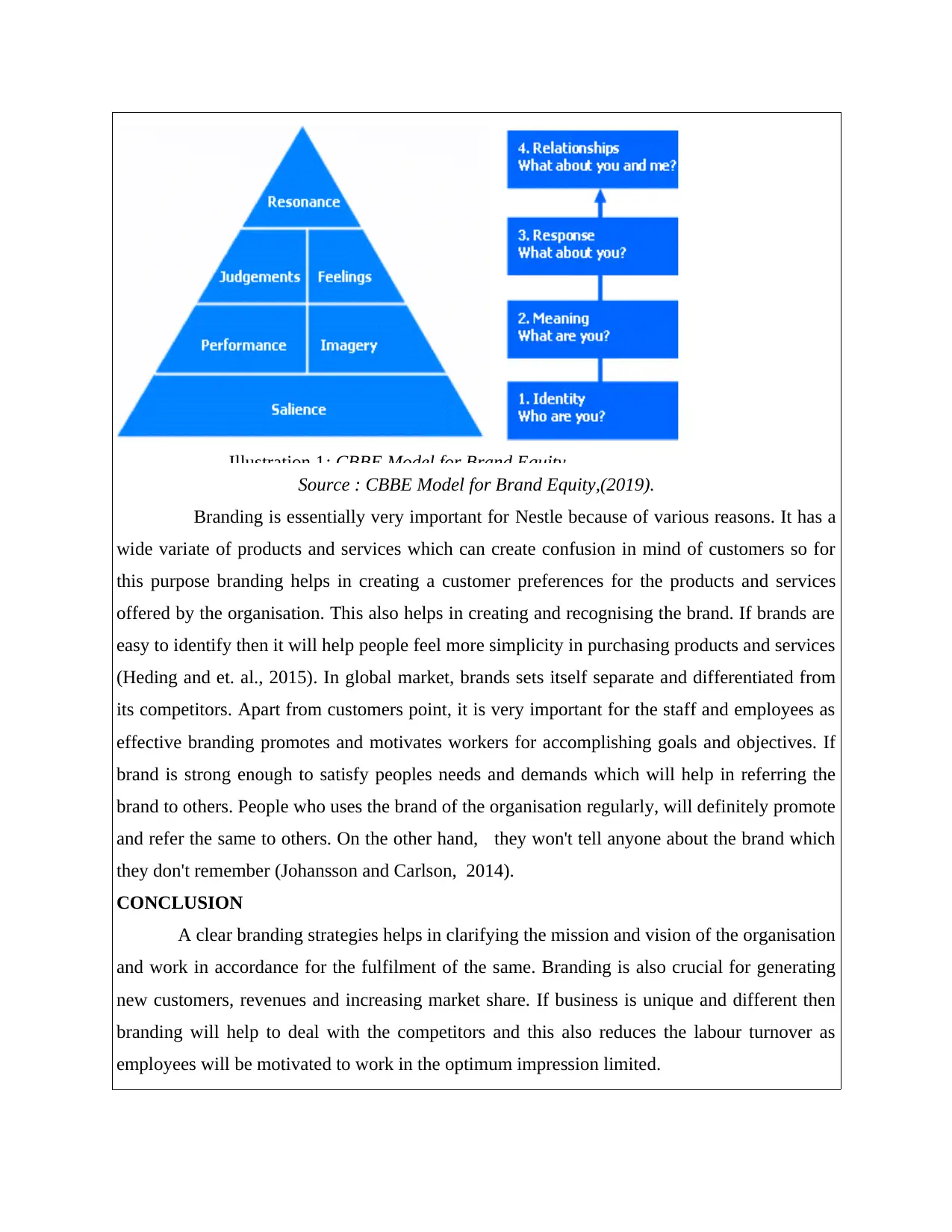
Illustration 1: CBBE Model for Brand Equity
Source : CBBE Model for Brand Equity,(2019).
Branding is essentially very important for Nestle because of various reasons. It has a
wide variate of products and services which can create confusion in mind of customers so for
this purpose branding helps in creating a customer preferences for the products and services
offered by the organisation. This also helps in creating and recognising the brand. If brands are
easy to identify then it will help people feel more simplicity in purchasing products and services
(Heding and et. al., 2015). In global market, brands sets itself separate and differentiated from
its competitors. Apart from customers point, it is very important for the staff and employees as
effective branding promotes and motivates workers for accomplishing goals and objectives. If
brand is strong enough to satisfy peoples needs and demands which will help in referring the
brand to others. People who uses the brand of the organisation regularly, will definitely promote
and refer the same to others. On the other hand, they won't tell anyone about the brand which
they don't remember (Johansson and Carlson, 2014).
CONCLUSION
A clear branding strategies helps in clarifying the mission and vision of the organisation
and work in accordance for the fulfilment of the same. Branding is also crucial for generating
new customers, revenues and increasing market share. If business is unique and different then
branding will help to deal with the competitors and this also reduces the labour turnover as
employees will be motivated to work in the optimum impression limited.
Source : CBBE Model for Brand Equity,(2019).
Branding is essentially very important for Nestle because of various reasons. It has a
wide variate of products and services which can create confusion in mind of customers so for
this purpose branding helps in creating a customer preferences for the products and services
offered by the organisation. This also helps in creating and recognising the brand. If brands are
easy to identify then it will help people feel more simplicity in purchasing products and services
(Heding and et. al., 2015). In global market, brands sets itself separate and differentiated from
its competitors. Apart from customers point, it is very important for the staff and employees as
effective branding promotes and motivates workers for accomplishing goals and objectives. If
brand is strong enough to satisfy peoples needs and demands which will help in referring the
brand to others. People who uses the brand of the organisation regularly, will definitely promote
and refer the same to others. On the other hand, they won't tell anyone about the brand which
they don't remember (Johansson and Carlson, 2014).
CONCLUSION
A clear branding strategies helps in clarifying the mission and vision of the organisation
and work in accordance for the fulfilment of the same. Branding is also crucial for generating
new customers, revenues and increasing market share. If business is unique and different then
branding will help to deal with the competitors and this also reduces the labour turnover as
employees will be motivated to work in the optimum impression limited.
⊘ This is a preview!⊘
Do you want full access?
Subscribe today to unlock all pages.

Trusted by 1+ million students worldwide
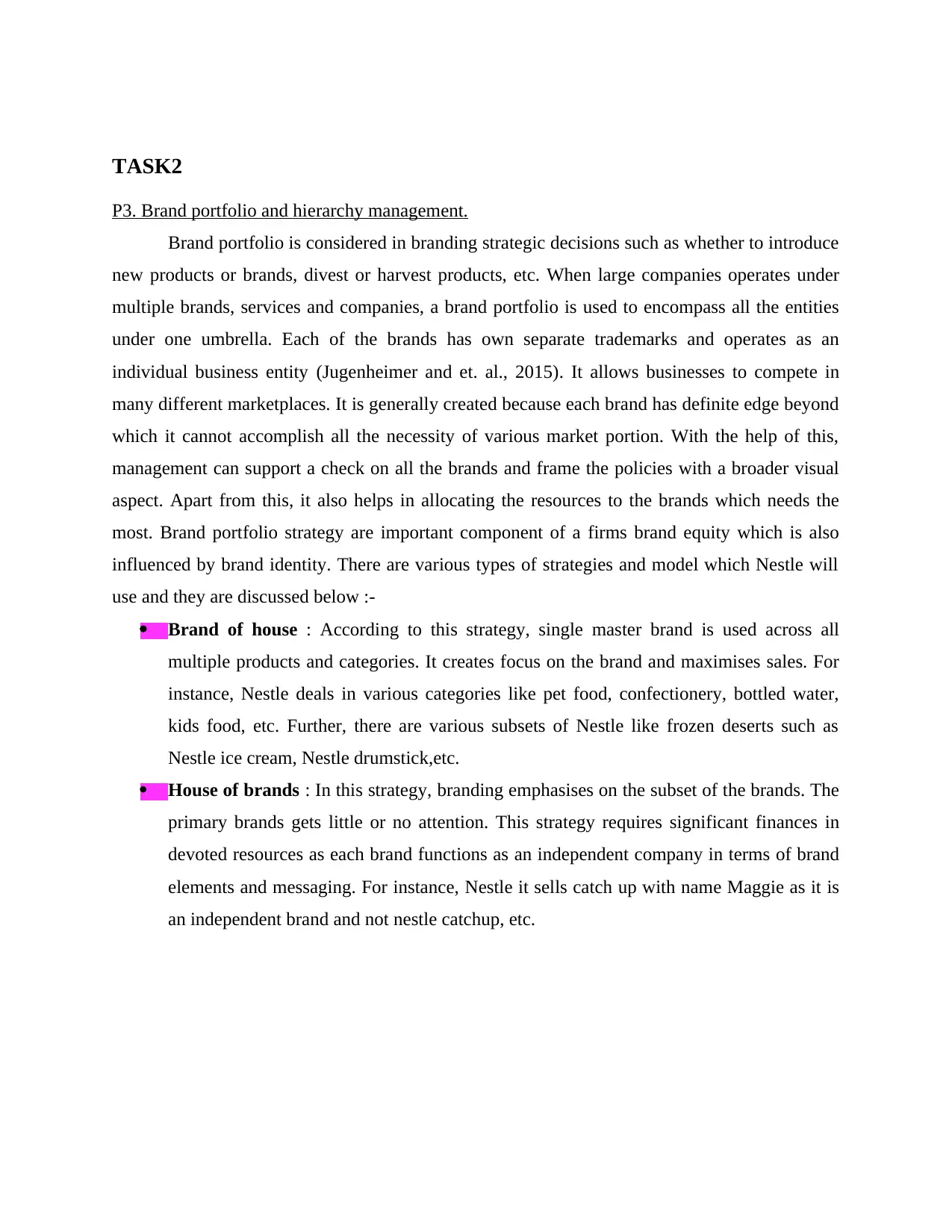
TASK2
P3. Brand portfolio and hierarchy management.
Brand portfolio is considered in branding strategic decisions such as whether to introduce
new products or brands, divest or harvest products, etc. When large companies operates under
multiple brands, services and companies, a brand portfolio is used to encompass all the entities
under one umbrella. Each of the brands has own separate trademarks and operates as an
individual business entity (Jugenheimer and et. al., 2015). It allows businesses to compete in
many different marketplaces. It is generally created because each brand has definite edge beyond
which it cannot accomplish all the necessity of various market portion. With the help of this,
management can support a check on all the brands and frame the policies with a broader visual
aspect. Apart from this, it also helps in allocating the resources to the brands which needs the
most. Brand portfolio strategy are important component of a firms brand equity which is also
influenced by brand identity. There are various types of strategies and model which Nestle will
use and they are discussed below :-
Brand of house : According to this strategy, single master brand is used across all
multiple products and categories. It creates focus on the brand and maximises sales. For
instance, Nestle deals in various categories like pet food, confectionery, bottled water,
kids food, etc. Further, there are various subsets of Nestle like frozen deserts such as
Nestle ice cream, Nestle drumstick,etc.
House of brands : In this strategy, branding emphasises on the subset of the brands. The
primary brands gets little or no attention. This strategy requires significant finances in
devoted resources as each brand functions as an independent company in terms of brand
elements and messaging. For instance, Nestle it sells catch up with name Maggie as it is
an independent brand and not nestle catchup, etc.
P3. Brand portfolio and hierarchy management.
Brand portfolio is considered in branding strategic decisions such as whether to introduce
new products or brands, divest or harvest products, etc. When large companies operates under
multiple brands, services and companies, a brand portfolio is used to encompass all the entities
under one umbrella. Each of the brands has own separate trademarks and operates as an
individual business entity (Jugenheimer and et. al., 2015). It allows businesses to compete in
many different marketplaces. It is generally created because each brand has definite edge beyond
which it cannot accomplish all the necessity of various market portion. With the help of this,
management can support a check on all the brands and frame the policies with a broader visual
aspect. Apart from this, it also helps in allocating the resources to the brands which needs the
most. Brand portfolio strategy are important component of a firms brand equity which is also
influenced by brand identity. There are various types of strategies and model which Nestle will
use and they are discussed below :-
Brand of house : According to this strategy, single master brand is used across all
multiple products and categories. It creates focus on the brand and maximises sales. For
instance, Nestle deals in various categories like pet food, confectionery, bottled water,
kids food, etc. Further, there are various subsets of Nestle like frozen deserts such as
Nestle ice cream, Nestle drumstick,etc.
House of brands : In this strategy, branding emphasises on the subset of the brands. The
primary brands gets little or no attention. This strategy requires significant finances in
devoted resources as each brand functions as an independent company in terms of brand
elements and messaging. For instance, Nestle it sells catch up with name Maggie as it is
an independent brand and not nestle catchup, etc.
Paraphrase This Document
Need a fresh take? Get an instant paraphrase of this document with our AI Paraphraser
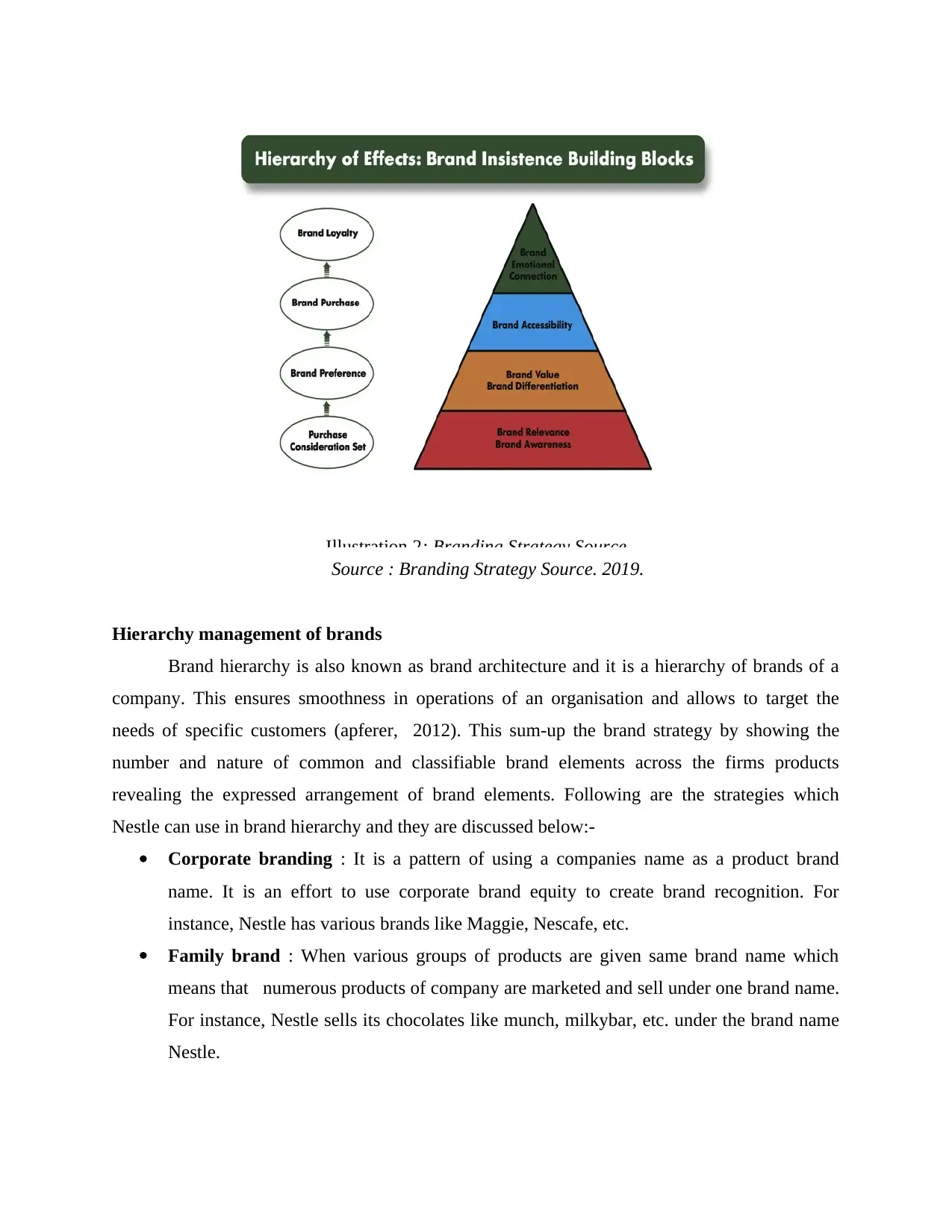
Source : Branding Strategy Source. 2019.
Hierarchy management of brands
Brand hierarchy is also known as brand architecture and it is a hierarchy of brands of a
company. This ensures smoothness in operations of an organisation and allows to target the
needs of specific customers (apferer, 2012). This sum-up the brand strategy by showing the
number and nature of common and classifiable brand elements across the firms products
revealing the expressed arrangement of brand elements. Following are the strategies which
Nestle can use in brand hierarchy and they are discussed below:-
Corporate branding : It is a pattern of using a companies name as a product brand
name. It is an effort to use corporate brand equity to create brand recognition. For
instance, Nestle has various brands like Maggie, Nescafe, etc.
Family brand : When various groups of products are given same brand name which
means that numerous products of company are marketed and sell under one brand name.
For instance, Nestle sells its chocolates like munch, milkybar, etc. under the brand name
Nestle.
Illustration 2: Branding Strategy Source
Hierarchy management of brands
Brand hierarchy is also known as brand architecture and it is a hierarchy of brands of a
company. This ensures smoothness in operations of an organisation and allows to target the
needs of specific customers (apferer, 2012). This sum-up the brand strategy by showing the
number and nature of common and classifiable brand elements across the firms products
revealing the expressed arrangement of brand elements. Following are the strategies which
Nestle can use in brand hierarchy and they are discussed below:-
Corporate branding : It is a pattern of using a companies name as a product brand
name. It is an effort to use corporate brand equity to create brand recognition. For
instance, Nestle has various brands like Maggie, Nescafe, etc.
Family brand : When various groups of products are given same brand name which
means that numerous products of company are marketed and sell under one brand name.
For instance, Nestle sells its chocolates like munch, milkybar, etc. under the brand name
Nestle.
Illustration 2: Branding Strategy Source
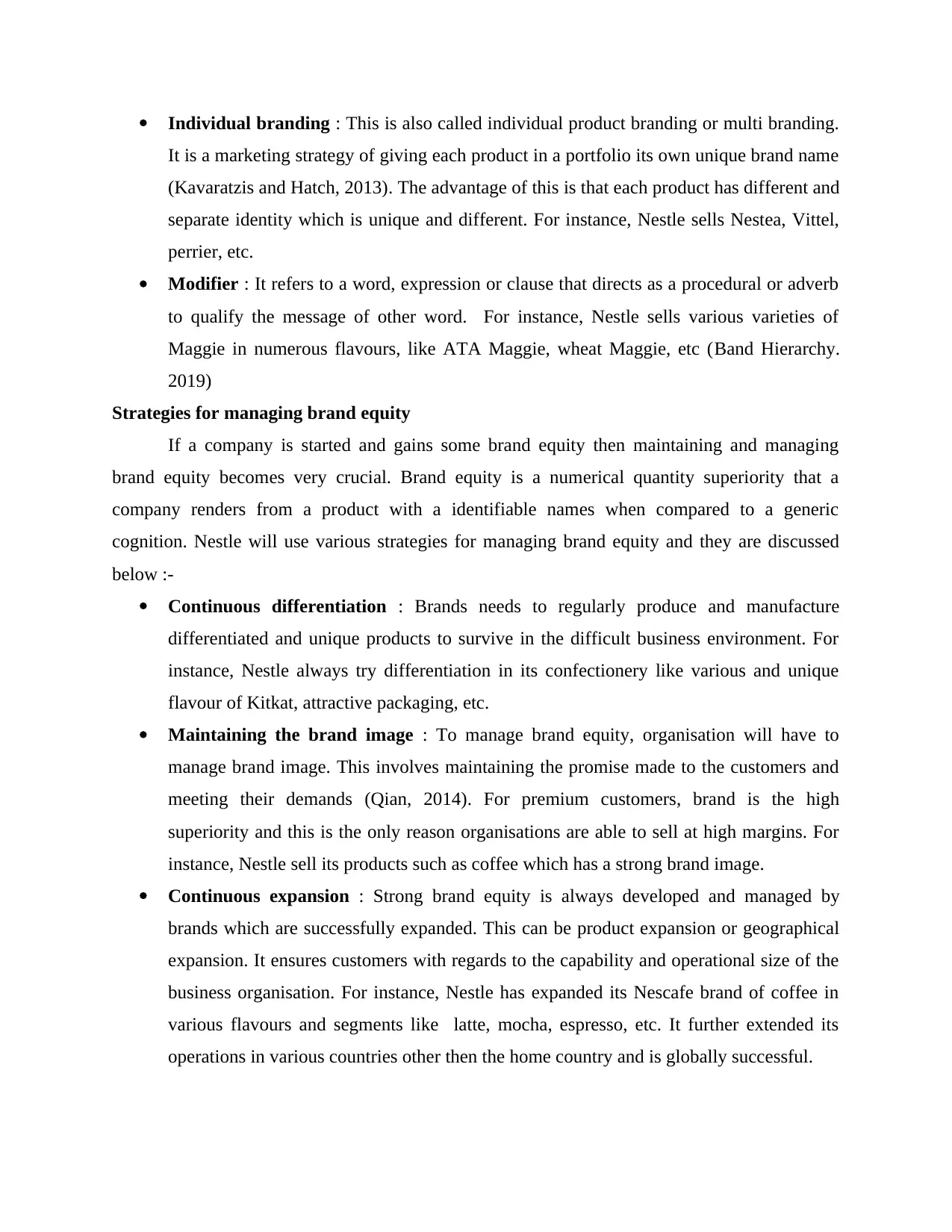
Individual branding : This is also called individual product branding or multi branding.
It is a marketing strategy of giving each product in a portfolio its own unique brand name
(Kavaratzis and Hatch, 2013). The advantage of this is that each product has different and
separate identity which is unique and different. For instance, Nestle sells Nestea, Vittel,
perrier, etc.
Modifier : It refers to a word, expression or clause that directs as a procedural or adverb
to qualify the message of other word. For instance, Nestle sells various varieties of
Maggie in numerous flavours, like ATA Maggie, wheat Maggie, etc (Band Hierarchy.
2019)
Strategies for managing brand equity
If a company is started and gains some brand equity then maintaining and managing
brand equity becomes very crucial. Brand equity is a numerical quantity superiority that a
company renders from a product with a identifiable names when compared to a generic
cognition. Nestle will use various strategies for managing brand equity and they are discussed
below :-
Continuous differentiation : Brands needs to regularly produce and manufacture
differentiated and unique products to survive in the difficult business environment. For
instance, Nestle always try differentiation in its confectionery like various and unique
flavour of Kitkat, attractive packaging, etc.
Maintaining the brand image : To manage brand equity, organisation will have to
manage brand image. This involves maintaining the promise made to the customers and
meeting their demands (Qian, 2014). For premium customers, brand is the high
superiority and this is the only reason organisations are able to sell at high margins. For
instance, Nestle sell its products such as coffee which has a strong brand image.
Continuous expansion : Strong brand equity is always developed and managed by
brands which are successfully expanded. This can be product expansion or geographical
expansion. It ensures customers with regards to the capability and operational size of the
business organisation. For instance, Nestle has expanded its Nescafe brand of coffee in
various flavours and segments like latte, mocha, espresso, etc. It further extended its
operations in various countries other then the home country and is globally successful.
It is a marketing strategy of giving each product in a portfolio its own unique brand name
(Kavaratzis and Hatch, 2013). The advantage of this is that each product has different and
separate identity which is unique and different. For instance, Nestle sells Nestea, Vittel,
perrier, etc.
Modifier : It refers to a word, expression or clause that directs as a procedural or adverb
to qualify the message of other word. For instance, Nestle sells various varieties of
Maggie in numerous flavours, like ATA Maggie, wheat Maggie, etc (Band Hierarchy.
2019)
Strategies for managing brand equity
If a company is started and gains some brand equity then maintaining and managing
brand equity becomes very crucial. Brand equity is a numerical quantity superiority that a
company renders from a product with a identifiable names when compared to a generic
cognition. Nestle will use various strategies for managing brand equity and they are discussed
below :-
Continuous differentiation : Brands needs to regularly produce and manufacture
differentiated and unique products to survive in the difficult business environment. For
instance, Nestle always try differentiation in its confectionery like various and unique
flavour of Kitkat, attractive packaging, etc.
Maintaining the brand image : To manage brand equity, organisation will have to
manage brand image. This involves maintaining the promise made to the customers and
meeting their demands (Qian, 2014). For premium customers, brand is the high
superiority and this is the only reason organisations are able to sell at high margins. For
instance, Nestle sell its products such as coffee which has a strong brand image.
Continuous expansion : Strong brand equity is always developed and managed by
brands which are successfully expanded. This can be product expansion or geographical
expansion. It ensures customers with regards to the capability and operational size of the
business organisation. For instance, Nestle has expanded its Nescafe brand of coffee in
various flavours and segments like latte, mocha, espresso, etc. It further extended its
operations in various countries other then the home country and is globally successful.
⊘ This is a preview!⊘
Do you want full access?
Subscribe today to unlock all pages.

Trusted by 1+ million students worldwide
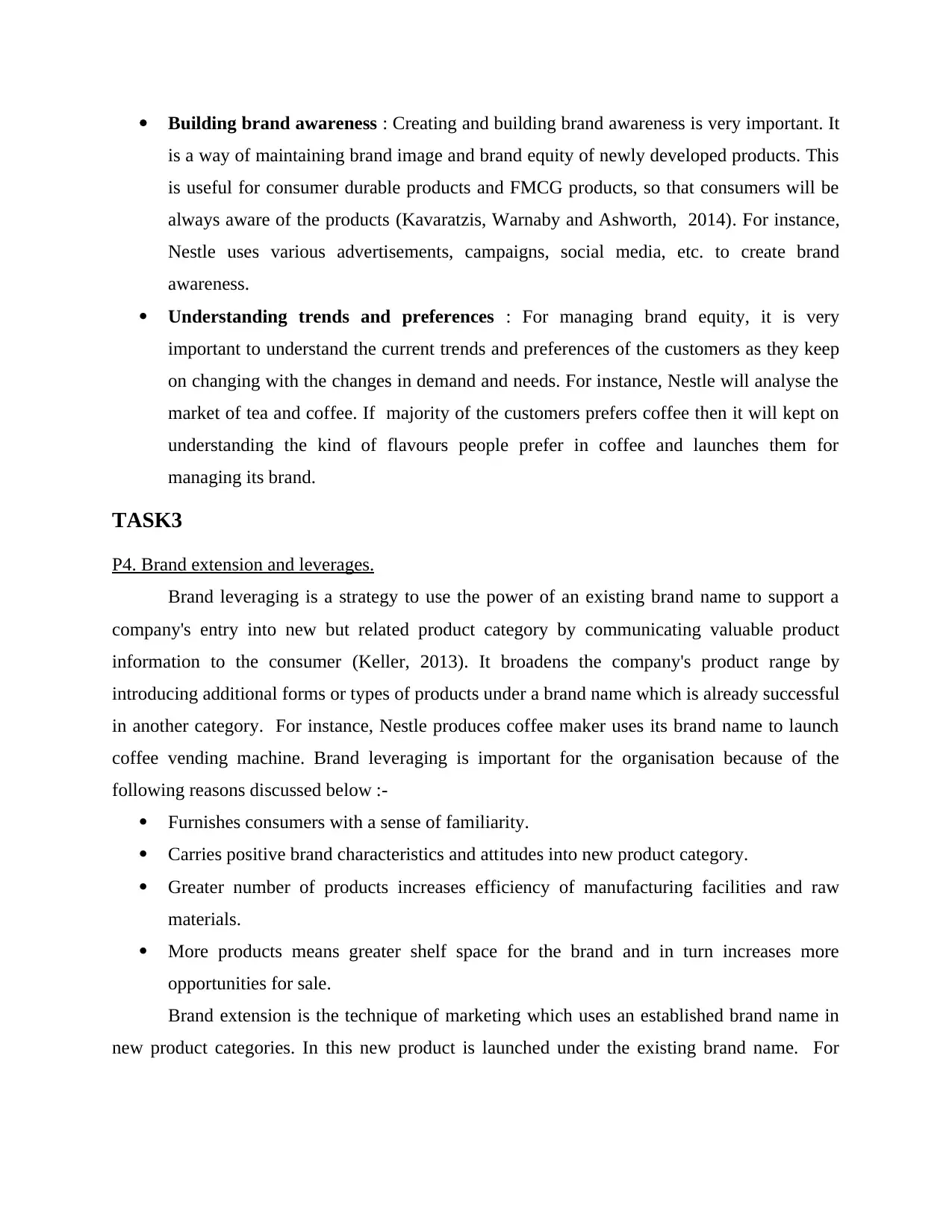
Building brand awareness : Creating and building brand awareness is very important. It
is a way of maintaining brand image and brand equity of newly developed products. This
is useful for consumer durable products and FMCG products, so that consumers will be
always aware of the products (Kavaratzis, Warnaby and Ashworth, 2014). For instance,
Nestle uses various advertisements, campaigns, social media, etc. to create brand
awareness.
Understanding trends and preferences : For managing brand equity, it is very
important to understand the current trends and preferences of the customers as they keep
on changing with the changes in demand and needs. For instance, Nestle will analyse the
market of tea and coffee. If majority of the customers prefers coffee then it will kept on
understanding the kind of flavours people prefer in coffee and launches them for
managing its brand.
TASK3
P4. Brand extension and leverages.
Brand leveraging is a strategy to use the power of an existing brand name to support a
company's entry into new but related product category by communicating valuable product
information to the consumer (Keller, 2013). It broadens the company's product range by
introducing additional forms or types of products under a brand name which is already successful
in another category. For instance, Nestle produces coffee maker uses its brand name to launch
coffee vending machine. Brand leveraging is important for the organisation because of the
following reasons discussed below :-
Furnishes consumers with a sense of familiarity.
Carries positive brand characteristics and attitudes into new product category.
Greater number of products increases efficiency of manufacturing facilities and raw
materials.
More products means greater shelf space for the brand and in turn increases more
opportunities for sale.
Brand extension is the technique of marketing which uses an established brand name in
new product categories. In this new product is launched under the existing brand name. For
is a way of maintaining brand image and brand equity of newly developed products. This
is useful for consumer durable products and FMCG products, so that consumers will be
always aware of the products (Kavaratzis, Warnaby and Ashworth, 2014). For instance,
Nestle uses various advertisements, campaigns, social media, etc. to create brand
awareness.
Understanding trends and preferences : For managing brand equity, it is very
important to understand the current trends and preferences of the customers as they keep
on changing with the changes in demand and needs. For instance, Nestle will analyse the
market of tea and coffee. If majority of the customers prefers coffee then it will kept on
understanding the kind of flavours people prefer in coffee and launches them for
managing its brand.
TASK3
P4. Brand extension and leverages.
Brand leveraging is a strategy to use the power of an existing brand name to support a
company's entry into new but related product category by communicating valuable product
information to the consumer (Keller, 2013). It broadens the company's product range by
introducing additional forms or types of products under a brand name which is already successful
in another category. For instance, Nestle produces coffee maker uses its brand name to launch
coffee vending machine. Brand leveraging is important for the organisation because of the
following reasons discussed below :-
Furnishes consumers with a sense of familiarity.
Carries positive brand characteristics and attitudes into new product category.
Greater number of products increases efficiency of manufacturing facilities and raw
materials.
More products means greater shelf space for the brand and in turn increases more
opportunities for sale.
Brand extension is the technique of marketing which uses an established brand name in
new product categories. In this new product is launched under the existing brand name. For
Paraphrase This Document
Need a fresh take? Get an instant paraphrase of this document with our AI Paraphraser
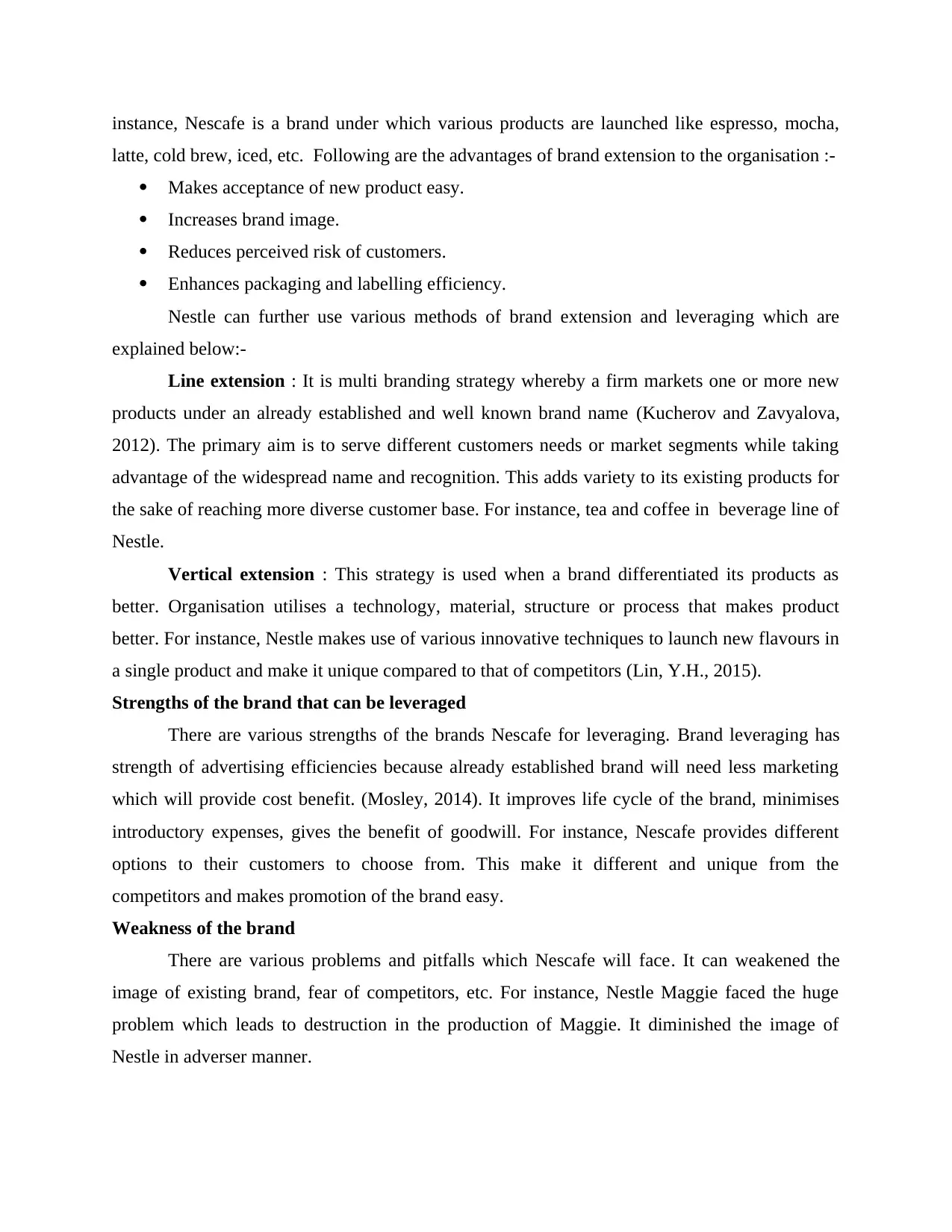
instance, Nescafe is a brand under which various products are launched like espresso, mocha,
latte, cold brew, iced, etc. Following are the advantages of brand extension to the organisation :-
Makes acceptance of new product easy.
Increases brand image.
Reduces perceived risk of customers.
Enhances packaging and labelling efficiency.
Nestle can further use various methods of brand extension and leveraging which are
explained below:-
Line extension : It is multi branding strategy whereby a firm markets one or more new
products under an already established and well known brand name (Kucherov and Zavyalova,
2012). The primary aim is to serve different customers needs or market segments while taking
advantage of the widespread name and recognition. This adds variety to its existing products for
the sake of reaching more diverse customer base. For instance, tea and coffee in beverage line of
Nestle.
Vertical extension : This strategy is used when a brand differentiated its products as
better. Organisation utilises a technology, material, structure or process that makes product
better. For instance, Nestle makes use of various innovative techniques to launch new flavours in
a single product and make it unique compared to that of competitors (Lin, Y.H., 2015).
Strengths of the brand that can be leveraged
There are various strengths of the brands Nescafe for leveraging. Brand leveraging has
strength of advertising efficiencies because already established brand will need less marketing
which will provide cost benefit. (Mosley, 2014). It improves life cycle of the brand, minimises
introductory expenses, gives the benefit of goodwill. For instance, Nescafe provides different
options to their customers to choose from. This make it different and unique from the
competitors and makes promotion of the brand easy.
Weakness of the brand
There are various problems and pitfalls which Nescafe will face. It can weakened the
image of existing brand, fear of competitors, etc. For instance, Nestle Maggie faced the huge
problem which leads to destruction in the production of Maggie. It diminished the image of
Nestle in adverser manner.
latte, cold brew, iced, etc. Following are the advantages of brand extension to the organisation :-
Makes acceptance of new product easy.
Increases brand image.
Reduces perceived risk of customers.
Enhances packaging and labelling efficiency.
Nestle can further use various methods of brand extension and leveraging which are
explained below:-
Line extension : It is multi branding strategy whereby a firm markets one or more new
products under an already established and well known brand name (Kucherov and Zavyalova,
2012). The primary aim is to serve different customers needs or market segments while taking
advantage of the widespread name and recognition. This adds variety to its existing products for
the sake of reaching more diverse customer base. For instance, tea and coffee in beverage line of
Nestle.
Vertical extension : This strategy is used when a brand differentiated its products as
better. Organisation utilises a technology, material, structure or process that makes product
better. For instance, Nestle makes use of various innovative techniques to launch new flavours in
a single product and make it unique compared to that of competitors (Lin, Y.H., 2015).
Strengths of the brand that can be leveraged
There are various strengths of the brands Nescafe for leveraging. Brand leveraging has
strength of advertising efficiencies because already established brand will need less marketing
which will provide cost benefit. (Mosley, 2014). It improves life cycle of the brand, minimises
introductory expenses, gives the benefit of goodwill. For instance, Nescafe provides different
options to their customers to choose from. This make it different and unique from the
competitors and makes promotion of the brand easy.
Weakness of the brand
There are various problems and pitfalls which Nescafe will face. It can weakened the
image of existing brand, fear of competitors, etc. For instance, Nestle Maggie faced the huge
problem which leads to destruction in the production of Maggie. It diminished the image of
Nestle in adverser manner.
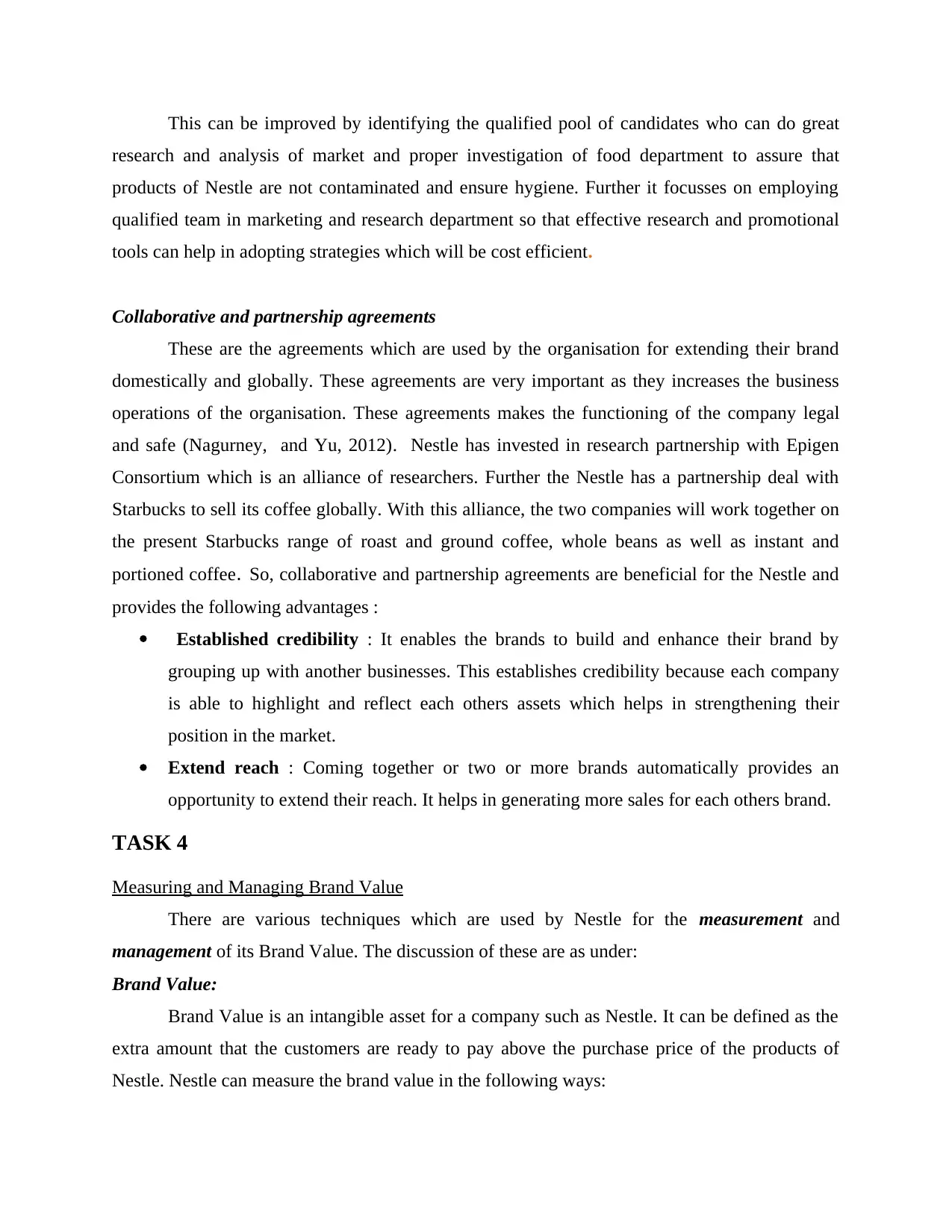
This can be improved by identifying the qualified pool of candidates who can do great
research and analysis of market and proper investigation of food department to assure that
products of Nestle are not contaminated and ensure hygiene. Further it focusses on employing
qualified team in marketing and research department so that effective research and promotional
tools can help in adopting strategies which will be cost efficient.
Collaborative and partnership agreements
These are the agreements which are used by the organisation for extending their brand
domestically and globally. These agreements are very important as they increases the business
operations of the organisation. These agreements makes the functioning of the company legal
and safe (Nagurney, and Yu, 2012). Nestle has invested in research partnership with Epigen
Consortium which is an alliance of researchers. Further the Nestle has a partnership deal with
Starbucks to sell its coffee globally. With this alliance, the two companies will work together on
the present Starbucks range of roast and ground coffee, whole beans as well as instant and
portioned coffee. So, collaborative and partnership agreements are beneficial for the Nestle and
provides the following advantages :
Established credibility : It enables the brands to build and enhance their brand by
grouping up with another businesses. This establishes credibility because each company
is able to highlight and reflect each others assets which helps in strengthening their
position in the market.
Extend reach : Coming together or two or more brands automatically provides an
opportunity to extend their reach. It helps in generating more sales for each others brand.
TASK 4
Measuring and Managing Brand Value
There are various techniques which are used by Nestle for the measurement and
management of its Brand Value. The discussion of these are as under:
Brand Value:
Brand Value is an intangible asset for a company such as Nestle. It can be defined as the
extra amount that the customers are ready to pay above the purchase price of the products of
Nestle. Nestle can measure the brand value in the following ways:
research and analysis of market and proper investigation of food department to assure that
products of Nestle are not contaminated and ensure hygiene. Further it focusses on employing
qualified team in marketing and research department so that effective research and promotional
tools can help in adopting strategies which will be cost efficient.
Collaborative and partnership agreements
These are the agreements which are used by the organisation for extending their brand
domestically and globally. These agreements are very important as they increases the business
operations of the organisation. These agreements makes the functioning of the company legal
and safe (Nagurney, and Yu, 2012). Nestle has invested in research partnership with Epigen
Consortium which is an alliance of researchers. Further the Nestle has a partnership deal with
Starbucks to sell its coffee globally. With this alliance, the two companies will work together on
the present Starbucks range of roast and ground coffee, whole beans as well as instant and
portioned coffee. So, collaborative and partnership agreements are beneficial for the Nestle and
provides the following advantages :
Established credibility : It enables the brands to build and enhance their brand by
grouping up with another businesses. This establishes credibility because each company
is able to highlight and reflect each others assets which helps in strengthening their
position in the market.
Extend reach : Coming together or two or more brands automatically provides an
opportunity to extend their reach. It helps in generating more sales for each others brand.
TASK 4
Measuring and Managing Brand Value
There are various techniques which are used by Nestle for the measurement and
management of its Brand Value. The discussion of these are as under:
Brand Value:
Brand Value is an intangible asset for a company such as Nestle. It can be defined as the
extra amount that the customers are ready to pay above the purchase price of the products of
Nestle. Nestle can measure the brand value in the following ways:
⊘ This is a preview!⊘
Do you want full access?
Subscribe today to unlock all pages.

Trusted by 1+ million students worldwide
1 out of 18
Related Documents
Your All-in-One AI-Powered Toolkit for Academic Success.
+13062052269
info@desklib.com
Available 24*7 on WhatsApp / Email
![[object Object]](/_next/static/media/star-bottom.7253800d.svg)
Unlock your academic potential
Copyright © 2020–2025 A2Z Services. All Rights Reserved. Developed and managed by ZUCOL.




